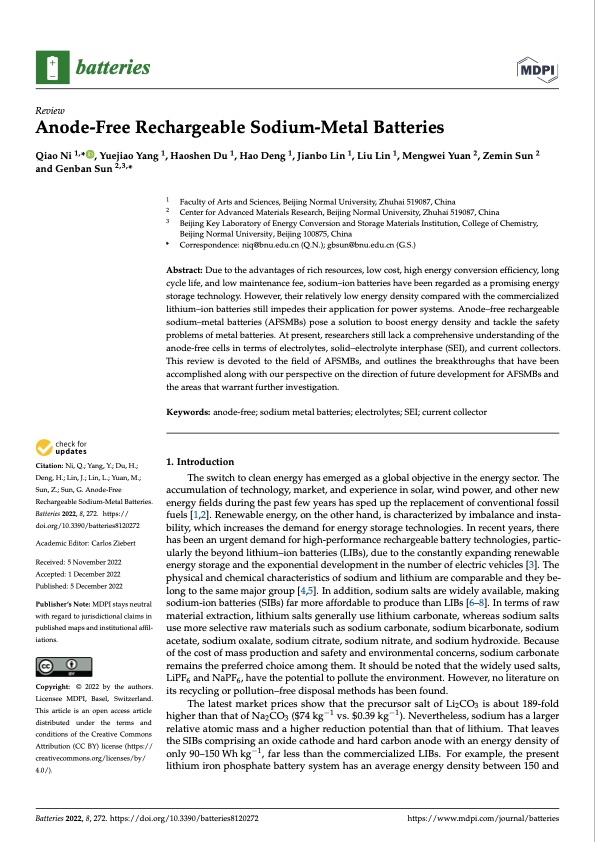
PDF Publication Title:
Text from PDF Page: 001
batteries Review Anode-Free Rechargeable Sodium-Metal Batteries Qiao Ni 1,* , Yuejiao Yang 1, Haoshen Du 1, Hao Deng 1, Jianbo Lin 1, Liu Lin 1, Mengwei Yuan 2, Zemin Sun 2 and Genban Sun 2,3,* 1 2 3 * Correspondence: niq@bnu.edu.cn (Q.N.); gbsun@bnu.edu.cn (G.S.) Abstract: Due to the advantages of rich resources, low cost, high energy conversion efficiency, long cycle life, and low maintenance fee, sodium–ion batteries have been regarded as a promising energy storage technology. However, their relatively low energy density compared with the commercialized lithium–ion batteries still impedes their application for power systems. Anode–free rechargeable sodium–metal batteries (AFSMBs) pose a solution to boost energy density and tackle the safety problems of metal batteries. At present, researchers still lack a comprehensive understanding of the anode-free cells in terms of electrolytes, solid–electrolyte interphase (SEI), and current collectors. This review is devoted to the field of AFSMBs, and outlines the breakthroughs that have been accomplished along with our perspective on the direction of future development for AFSMBs and the areas that warrant further investigation. Keywords: anode-free; sodium metal batteries; electrolytes; SEI; current collector 1. Introduction The switch to clean energy has emerged as a global objective in the energy sector. The accumulation of technology, market, and experience in solar, wind power, and other new energy fields during the past few years has sped up the replacement of conventional fossil fuels [1,2]. Renewable energy, on the other hand, is characterized by imbalance and insta- bility, which increases the demand for energy storage technologies. In recent years, there has been an urgent demand for high-performance rechargeable battery technologies, partic- ularly the beyond lithium–ion batteries (LIBs), due to the constantly expanding renewable energy storage and the exponential development in the number of electric vehicles [3]. The physical and chemical characteristics of sodium and lithium are comparable and they be- long to the same major group [4,5]. In addition, sodium salts are widely available, making sodium-ion batteries (SIBs) far more affordable to produce than LIBs [6–8]. In terms of raw material extraction, lithium salts generally use lithium carbonate, whereas sodium salts use more selective raw materials such as sodium carbonate, sodium bicarbonate, sodium acetate, sodium oxalate, sodium citrate, sodium nitrate, and sodium hydroxide. Because of the cost of mass production and safety and environmental concerns, sodium carbonate remains the preferred choice among them. It should be noted that the widely used salts, LiPF6 and NaPF6, have the potential to pollute the environment. However, no literature on its recycling or pollution–free disposal methods has been found. The latest market prices show that the precursor salt of Li2CO3 is about 189-fold higher than that of Na2CO3 ($74 kg−1 vs. $0.39 kg−1). Nevertheless, sodium has a larger relative atomic mass and a higher reduction potential than that of lithium. That leaves the SIBs comprising an oxide cathode and hard carbon anode with an energy density of only 90–150 Wh kg−1, far less than the commercialized LIBs. For example, the present lithium iron phosphate battery system has an average energy density between 150 and Faculty of Arts and Sciences, Beijing Normal University, Zhuhai 519087, China Center for Advanced Materials Research, Beijing Normal University, Zhuhai 519087, China Beijing Key Laboratory of Energy Conversion and Storage Materials Institution, College of Chemistry, Beijing Normal University, Beijing 100875, China Citation: Ni, Q.; Yang, Y.; Du, H.; Deng, H.; Lin, J.; Lin, L.; Yuan, M.; Sun, Z.; Sun, G. Anode-Free Rechargeable Sodium-Metal Batteries. Batteries2022,8,272. https:// doi.org/10.3390/batteries8120272 Academic Editor: Carlos Ziebert Received: 5 November 2022 Accepted: 1 December 2022 Published: 5 December 2022 Publisher’s Note: MDPI stays neutral with regard to jurisdictional claims in published maps and institutional affil- iations. Copyright: © 2022 by the authors. Licensee MDPI, Basel, Switzerland. This article is an open access article distributed under the terms and conditions of the Creative Commons Attribution (CC BY) license (https:// creativecommons.org/licenses/by/ 4.0/). Batteries 2022, 8, 272. https://doi.org/10.3390/batteries8120272 https://www.mdpi.com/journal/batteriesPDF Image | Anode-Free Rechargeable Sodium-Metal Batteries

PDF Search Title:
Anode-Free Rechargeable Sodium-Metal BatteriesOriginal File Name Searched:
batteries-08-00272.pdfDIY PDF Search: Google It | Yahoo | Bing
Salgenx Redox Flow Battery Technology: Salt water flow battery technology with low cost and great energy density that can be used for power storage and thermal storage. Let us de-risk your production using our license. Our aqueous flow battery is less cost than Tesla Megapack and available faster. Redox flow battery. No membrane needed like with Vanadium, or Bromine. Salgenx flow battery
| CONTACT TEL: 608-238-6001 Email: greg@salgenx.com | RSS | AMP |